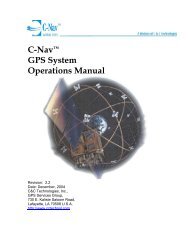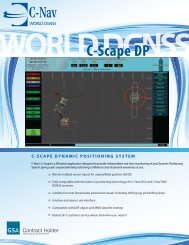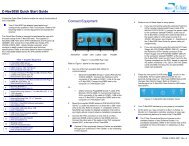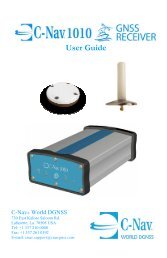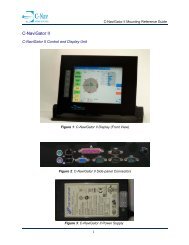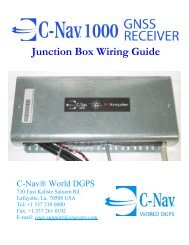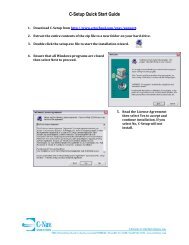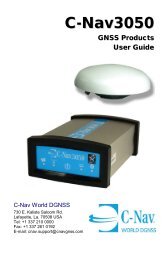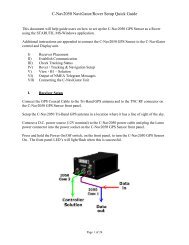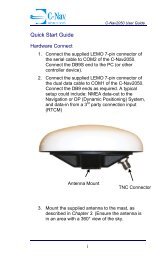Guidelines for the use of GNSS in surveying and mapping
Guidelines for the use of GNSS in surveying and mapping
Guidelines for the use of GNSS in surveying and mapping
You also want an ePaper? Increase the reach of your titles
YUMPU automatically turns print PDFs into web optimized ePapers that Google loves.
6 Co-ord<strong>in</strong>ate reference frames or systems<br />
As stated <strong>in</strong> Part 1, it is common to apply<br />
trans<strong>for</strong>mations to co-ord<strong>in</strong>ates generated <strong>in</strong> <strong>the</strong><br />
ma<strong>the</strong>matical reference system <strong>of</strong> <strong>GNSS</strong>. This<br />
section <strong>in</strong>troduces some <strong>of</strong> <strong>the</strong> important terms<br />
that should be considered <strong>in</strong> relation to co-ord<strong>in</strong>ate<br />
systems <strong>and</strong> trans<strong>for</strong>mation process. Co-ord<strong>in</strong>ate<br />
systems are discussed with an explanation <strong>of</strong> <strong>the</strong><br />
guidel<strong>in</strong>es as to why certa<strong>in</strong> types should be<br />
selected over o<strong>the</strong>rs <strong>for</strong> given projects <strong>and</strong><br />
applications (Part 1, section 3.4). F<strong>in</strong>ally, <strong>the</strong><br />
process <strong>of</strong> co-ord<strong>in</strong>ate trans<strong>for</strong>mation is discussed<br />
<strong>and</strong> some numerical <strong>for</strong>mulae are given <strong>for</strong> <strong>the</strong><br />
general cases.<br />
6.1 Description <strong>of</strong> <strong>the</strong> earth<br />
6.1.1 The geoid<br />
The geoid is <strong>the</strong> equipotential surface (a surface<br />
where gravitational potential is constant) <strong>of</strong> <strong>the</strong><br />
earth’s gravity field which best fits global mean sea<br />
level. Heights referred to sea level are <strong>the</strong>re<strong>for</strong>e<br />
related to <strong>the</strong> geoid <strong>and</strong> are termed orthometric<br />
heights. Sea level changes with time, <strong>and</strong> so most<br />
countries def<strong>in</strong>e <strong>the</strong> height <strong>of</strong> one po<strong>in</strong>t with<br />
respect to mean sea level over some time period<br />
<strong>and</strong> refer to this def<strong>in</strong>ed po<strong>in</strong>t as <strong>the</strong> levell<strong>in</strong>g<br />
datum. Positions determ<strong>in</strong>ed by geodetic<br />
astronomy are related to <strong>the</strong> geoid <strong>in</strong> as much as<br />
<strong>the</strong> axes <strong>of</strong> <strong>the</strong> <strong>in</strong>strument be<strong>in</strong>g <strong>use</strong>d are aligned<br />
<strong>in</strong> <strong>the</strong> direction <strong>of</strong>, <strong>and</strong> at right angles to, <strong>the</strong><br />
direction <strong>of</strong> gravity.<br />
6.1.2 The ellipsoid<br />
The ma<strong>the</strong>matics <strong>of</strong> comput<strong>in</strong>g <strong>the</strong> geoid are<br />
complicated, <strong>and</strong> various approximations to its<br />
shape have been made. As a first attempt, a<br />
spherical earth <strong>in</strong>troduces negligible error <strong>for</strong> some<br />
cartographic purposes; <strong>the</strong> attraction <strong>of</strong> this choice<br />
is that it is a surface with constant curvature.<br />
However, an ellipse <strong>of</strong> rotation, with semi-m<strong>in</strong>or<br />
axis <strong>in</strong> <strong>the</strong> polar plane <strong>and</strong> semi-major axis <strong>in</strong> <strong>the</strong><br />
equatorial plane, is a better match to <strong>the</strong> geoid.<br />
This shape (<strong>the</strong> ellipsoid) has been <strong>use</strong>d <strong>for</strong><br />
geodetic purposes <strong>for</strong> over two hundred years. A<br />
variety <strong>of</strong> ‘best-fitt<strong>in</strong>g’ ellipsoids (ma<strong>in</strong>ly national,<br />
regional or global), each with a different size <strong>and</strong><br />
orientation to <strong>the</strong> earth’s sp<strong>in</strong> axis, have been <strong>use</strong>d.<br />
6.1.3 Datums <strong>and</strong> co-ord<strong>in</strong>ate frames<br />
Each <strong>GNSS</strong> system has its own datum: <strong>for</strong> example<br />
GPS <strong>use</strong>s WGS 84. A datum <strong>in</strong> this context is<br />
essentially a set <strong>of</strong> conventions, constra<strong>in</strong>ts <strong>and</strong><br />
<strong>for</strong>mulae which def<strong>in</strong>e it without recourse to a<br />
physical <strong>in</strong>frastructure. In order to <strong>use</strong> this datum<br />
practically it must be physically realised. This is<br />
achieved by means <strong>of</strong> a known network <strong>of</strong> po<strong>in</strong>ts<br />
with def<strong>in</strong>ed co-ord<strong>in</strong>ates, known as a terrestrial<br />
reference frame (TRF). Examples <strong>of</strong> such frames<br />
are:<br />
+ US Broadcast TRF (military track<strong>in</strong>g stations) –<br />
realises <strong>the</strong> WGS 84 datum <strong>and</strong> currently<br />
precise to about 5cm (see www.fig.net/pub/<br />
vietnam/ppt/ts06b/ts06b_higg<strong>in</strong>s_ppt_3792.pdf;<br />
all stations are now updated to realise ITRF<br />
20nn.05)<br />
+ IERS ITRF – realises, <strong>in</strong> name, <strong>the</strong> ITRS datum<br />
ra<strong>the</strong>r than WGS 84 although <strong>in</strong> practice <strong>the</strong><br />
two are practically identical. The frame is<br />
associated with a po<strong>in</strong>t <strong>in</strong> time <strong>and</strong> thus has a<br />
stated epoch<br />
+ European TRF – geographically fixed realisation<br />
<strong>of</strong> <strong>the</strong> ITRS datum at a particular epoch <strong>in</strong> time.<br />
It is fixed to def<strong>in</strong>ed reference po<strong>in</strong>ts <strong>and</strong><br />
moves with <strong>the</strong> European tectonic plate.<br />
ETRS89 was co<strong>in</strong>cident with ITRS at <strong>the</strong> start<br />
<strong>of</strong> 1989 (1989.0) <strong>and</strong> has s<strong>in</strong>ce been diverg<strong>in</strong>g<br />
from <strong>the</strong> WGS 84 <strong>and</strong> ITRS datums.<br />
It is possible to trans<strong>for</strong>m ITRF co-ord<strong>in</strong>ates to<br />
ETRF co-ord<strong>in</strong>ates by way <strong>of</strong> a six-parameter<br />
trans<strong>for</strong>mation (published by <strong>the</strong> IERS).<br />
Epoch dates are stated as years <strong>and</strong> months, <strong>and</strong><br />
written as YYYY.M (e.g. 1999.7). Users <strong>of</strong> precise<br />
ephemeris data will receive co-ord<strong>in</strong>ates related to<br />
<strong>the</strong> current epoch, but if survey campaigns are to<br />
extend over long periods, <strong>the</strong> epoch date to be<br />
<strong>use</strong>d should be stated.<br />
The International St<strong>and</strong>ardisation Organisation (ISO)<br />
produces numerous <strong>in</strong>ternationally recognised<br />
st<strong>and</strong>ards relat<strong>in</strong>g to geomatics <strong>and</strong> geodesy.<br />
42 | GUIDELINES FOR THE USE OF <strong>GNSS</strong> IN LAND SURVEYING AND MAPPING





